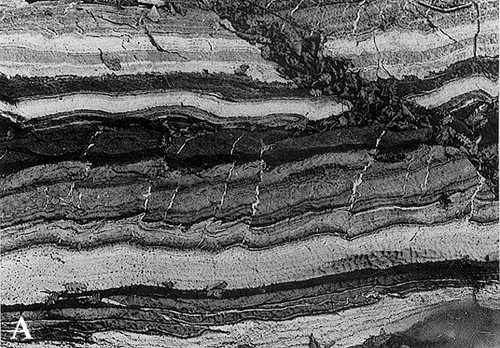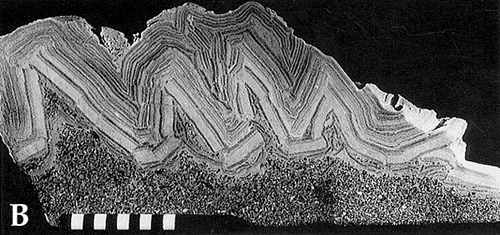

Tectonic deformations in sulfate evaporites
Plate 178


Tectonic deformations in sulfate evaporites
Plate 178
Evaporitic sediments are often indurated and brittle like crusts since their origin; even limited phenomena of dissolution and reprecipitation can weld their crystalline framework before they are buried. In other words, they constitute preconsolidated materials. When, upon burial, they are loaded, their behavior becomes ductile, i.e., similar to that of a plastic or semifluid substance. Owing, in fact, to the solubility of salts and the presence of hydrated minerals, a lot of water can be squeezed from evaporitic bodies and lubricate their movement. Two causes of deformation can be identified: gravity (load), and oriented tectonic stresses. The first cause induces diapirism, consisting in upward extrusion of salt masses (domes); more precisely, unequal loading of buried salt strata and density inversion with respect to overlying sediments (whose consolidation increases with depth of burial while evaporites, being preconsolidated, do not change in density) are the main causal factors of this form of instability.
Salt domes are large-scale features; at smaller scales, the deformation of evaporites is represented by intricate folds and flowage structures, partly similar to convolutions of clastic sediments. A folding style is also the response to tectonic stresses, as documented by the two pictures in plate 178, which illustrate compressed rocks (A from Messinian gypsum and oil shales of the Apennines; B from Triassic anhydrite and dolomite of Germany). The vergence of the small folds, in both cases, indicates the direction of relative movement that resulted from a shear couple, or rotational shear (the upper parts are displaced more than the lower parts).
Noteworthy is some evidence of brittle behavior in both examples: in A, some beds are crossed by veins, in B dolomite laminae interbedded with anhydrite are fractured and "kink-folded" (hinges of fold). The sericolite veins in A show small-scale (ptygmatic ) folding, which suggests fluid injection rather than fracture-filling and calls into question the rigidity of the mass.
| Photo: P. Ferrieri 1992. |